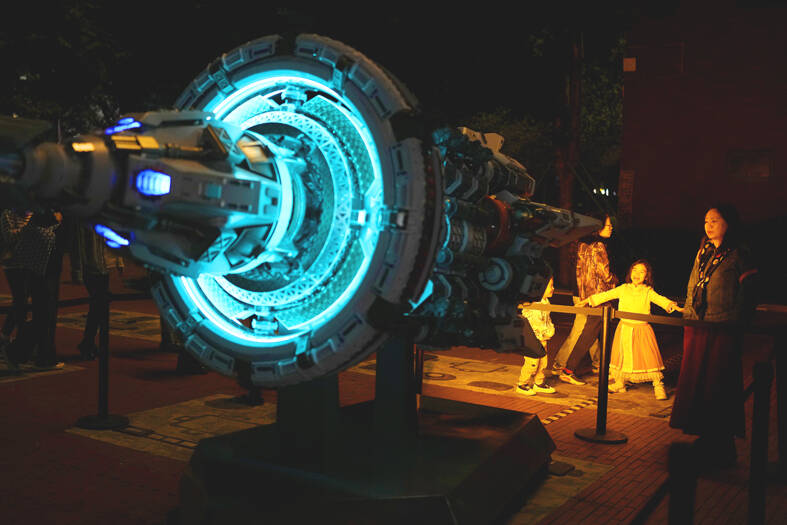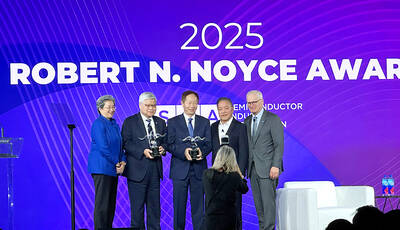Netflix’s blockbuster 3 Body Problem, an adaptation of the crown jewel of Chinese sci-fi, has sparked passionate debate and divided opinions among fans in the country, despite it not being available to watch there.
The streaming service is not officially operational in China, but that has not stopped devotees accessing the show, likely via virtual private network services or illegal streaming sites. Hashtags relating to the show have more than 2 billion views on Sina Weibo.
Among the tens of thousands of commentaries left on one reviewing platform, reactions ranged from disappointment at plot and character changes, to nationalistic outrage, to optimism that the show’s profile would boost representation of Chinese literature and film.

Photo: AP
The series is based on the three-part Remembrance of Earth’s Past (地球往事) series by Liu Cixin (?慈欣), a domestic superstar who readers sometimes jokingly call “God.”
“The original works have a huge influence. Many fans of the books know all the details of the characters in the books by heart, so they have a hard time accepting changes,” said Li Dongdong, founder of Chinese sci-fi film community Geek Movie.
Previous Chinese-produced adaptations have taken this obsessive attention to detail into account — Liu recently told a news conference he had suggested making a small visual change to a recurring plot device, only to be told: “You can’t change it beyond recognition.”
For many, the Netflix adaptation has very much done that. Spearheaded by the team behind megahit series Game of Thrones, it transfers most of the action to the UK and changes the nationalities and genders of some of the key characters.
One Chinese reviewer likened the series to “a plate of General Tso’s chicken,” a Westernised Chinese dish that can be used as a metaphor for inauthenticity and cultural misunderstanding.
Disagreement with the showrunners’ creative choices is not confined to China. The series was the most watched on Netflix by its second week, but reviews have been mixed, with Rolling Stone calling it “one great big miss.”
However, some of the Chinese criticism is tinged by politics, against a backdrop of tense US-China relations. Many commenters questioned the motive behind the decision to keep the villain Chinese while the heroes are mostly played by Westerners.
“Other things aside, the casting once again shows that Americans are [political] ideologues,” one of the most popular reviews said.
Others have taken issue with the show’s portrayal of Chinese history.
The show starts in the 1960s, with an ugly scene from the Cultural Revolution in which a physicist is killed by a mob for refusing to disown key scientific theories. Its use as the opening scene led some nationalists to accuse Netflix of making the entire show purely to portray China in a bad light.
“It’s making a whole tray of dumplings merely for tasting a bit of vinegar,” one Sina Weibo user wrote.
However, for 3 Body devotees the scene is key to understanding the motivations of the series’ antagonist.
“The storyline of the 1960s alone deserves a 5-star review,” one commenter wrote.
Other fans have warmed to the faster and simpler plot, which they say makes the work more accessible and appealing to the general public.
“Netflix’s adaptation makes me really understand the charm of this sci-fi work for the first time,” 31-year-old Beijing sci-fi fan Harry Zhou said, admitting that he had tried and failed to finish the original books several times.
The show’s popularity has also brought global attention to Liu’s work and Chinese sci-fi in general.
“People in other countries can now see that Chinese writers are capable of writing great sci-fi works. This will boost the presence of Chinese sci-fi,” Zhou said.
“I am sure that more people will reread the original story after watching this,” famed Japanese game creator Hideo Kojima wrote on X.
Netflix’s involvement is seen as a vote of confidence in the genre.
“Chinese sci-fi is getting recognition with real money investment... It’s a huge encouragement for the Chinese sci-fi creator community,” Li said. “It’s a small step for [Liu Cixin], but it’s a big step for Chinese sci-fi creation.”

Shiina Ito has had fewer Chinese customers at her Tokyo jewelry shop since Beijing issued a travel warning in the wake of a diplomatic spat, but she said she was not concerned. A souring of Tokyo-Beijing relations this month, following remarks by Japanese Prime Minister Sanae Takaichi about Taiwan, has fueled concerns about the impact on the ritzy boutiques, noodle joints and hotels where holidaymakers spend their cash. However, businesses in Tokyo largely shrugged off any anxiety. “Since there are fewer Chinese customers, it’s become a bit easier for Japanese shoppers to visit, so our sales haven’t really dropped,” Ito

The number of Taiwanese working in the US rose to a record high of 137,000 last year, driven largely by Taiwan Semiconductor Manufacturing Co’s (TSMC, 台積電) rapid overseas expansion, according to government data released yesterday. A total of 666,000 Taiwanese nationals were employed abroad last year, an increase of 45,000 from 2023 and the highest level since the COVID-19 pandemic, data from the Directorate-General of Budget, Accounting and Statistics (DGBAS) showed. Overseas employment had steadily increased between 2009 and 2019, peaking at 739,000, before plunging to 319,000 in 2021 amid US-China trade tensions, global supply chain shifts, reshoring by Taiwanese companies and

Taiwan Semiconductor Manufacturing Co (TSMC) Chairman C.C. Wei (魏哲家) and the company’s former chairman, Mark Liu (劉德音), both received the Robert N. Noyce Award -- the semiconductor industry’s highest honor -- in San Jose, California, on Thursday (local time). Speaking at the award event, Liu, who retired last year, expressed gratitude to his wife, his dissertation advisor at the University of California, Berkeley, his supervisors at AT&T Bell Laboratories -- where he worked on optical fiber communication systems before joining TSMC, TSMC partners, and industry colleagues. Liu said that working alongside TSMC

TECHNOLOGY DAY: The Taiwanese firm is also setting up a joint venture with Alphabet Inc on robots and plans to establish a firm in Japan to produce Model A EVs Manufacturing giant Hon Hai Precision Industry Co (鴻海精密) yesterday announced a collaboration with ChatGPT developer OpenAI to build next-generation artificial intelligence (AI) infrastructure and strengthen its local supply chain in the US to accelerate the deployment of advanced AI systems. Building such an infrastructure in the US is crucial for strengthening local supply chains and supporting the US in maintaining its leading position in the AI domain, Hon Hai said in a statement. Through the collaboration, OpenAI would share its insights into emerging hardware needs in the AI industry with Hon Hai to support the company’s design and development work, as well